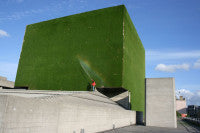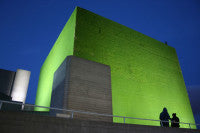Artists use BSH seed to produce most ambitious work
 If you were in the vicinity of the South Bank in London recently, you may have been startled by an incredible piece of horticultural art.
If you were in the vicinity of the South Bank in London recently, you may have been startled by an incredible piece of horticultural art.
Above the concrete façade of the National Theatre facing Waterloo Bridge, artists Heather Ackroyd and Dan Harvey completed FlyTower, their most ambitious project to date which involved covering the north and west faces of the iconic Lyttelton fly tower in grass.
The installation, which was commissioned by the National Theatre and covered an area of about 750 square metres, began in mid-May and will stay in place for almost six weeks. The artists and a team of 20 assistants applied a thin layer of a clay and fibre paste to the building before pushing handfuls of pre-germinated seed into the damp mixture.
The seed mixture was supplied by British Seed Houses and contained 50% perennial ryegrass mix, 40% fescue and 10% 'So-Green' which contains the cultivar AberNile, the revolutionary perennial ryegrass with 'stay green' technology bred by scientists at its turfgrass breeding programme at the Institute of Grassland and Environmental Research in Aberystwyth.
The work had originally been planned for September last year but was postponed because of the water restrictions in the South East. As many of the buildings along the South Bank are prone to flooding, this presented the theatre with an opportunity to look into the feasibility of rainwater harvesting. After testing groundwater from the theatre's car park to make sure it was clean enough to use, it was pumped up from the basement and used to prolong the life of the piece.

"The clay provided no nutrients to the plant, just a medium in which to establish, so although the piece was watered initially, it was always going to yellow and die eventually," explains Ackroyd. "We used perennial ryegrass for quick establishment and chose to include So-Green in the seed mixture because the seedlings were subjected to a number of environmental pressures - growing vertically with a clay base, limited water and no nutrients… hardly ideal growing conditions."
"What we created was the juxtaposition of nature and structure - a blank, green living canvas on a very polarized building. We think that green balms the eye and hope it brings a feeling of calm to those who see it in a built up area. It was never going to be possible to develop the seedlings past their initial growth stage but the decline of the piece over the weeks sends out a message about sustainability, water usage and climate change which both Dan and I are very interested in."
Ackroyd and Harvey have used BSH seed since 1998, after enlisting the help of research scientists at IGER in one of their first projects which involved using photosynthesis to imprint photographic images onto grass canvases. AberNile was used because of its unique ability to retain a rich, green colour under stress.
Article Tags:
Industry news